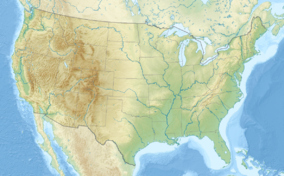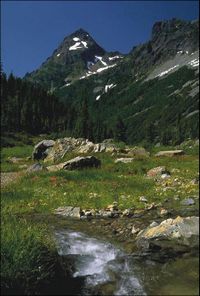- Mount Baker-Snoqualmie National Forest
-
Mount Baker-Snoqualmie National Forest IUCN Category VI (Managed Resource Protected Area)Location Washington, USA Nearest city Bellingham, WA Coordinates 48°52′59″N 121°53′05″W / 48.8831784°N 121.8845894°WCoordinates: 48°52′59″N 121°53′05″W / 48.8831784°N 121.8845894°W[1] Area 3998.9 sq mi (10357.2 km2) Governing body U.S. Forest Service The Mount Baker-Snoqualmie National Forest in Washington extends more than 140 miles (230 km) along the western slopes of the Cascade Range from the Canadian border to the northern boundary of Mount Rainier National Park. Forest headquarters are located in the city of Everett.
Contents
Visitation
Mt. Baker-Snoqualmie National Forest covers (in descending order of forestland area) portions of Snohomish, Whatcom, Skagit, King, Snohomish, Pierce, and Kittitas counties. It has a total area of 1,724,229 acres. Ranger district offices are located in Sedro-Woolley, Darrington, North Bend and Skykomish.
Together with the other central Puget Sound counties, 62% (3.63 million people) of the State's population lives within a 70-mile (110 km) drive of the Forests. Another 1.5 million in the Vancouver, British Columbia metro area are also within easy reach of the northern part of the Forests.
The large population factor, coupled with easy road access, makes the Mt. Baker-Snoqualmie National Forest one of the most visited National Forests in the country.
Geography
Mountains
The Mt. Baker-Snoqualmie National Forest contains many scenic and historical points of interest. Mountain tops gradually rise from 5,000 to 6,000 feet (1,800 m) on the south end of the forest to 7,000 to 8,000 feet (2,400 m) in the north. Two tall volcanoes, Mount Baker and Glacier Peak, tower thousands of feet above the adjacent ridges.
Glaciers
The Forest is home to more glaciers and snow fields than any other National Forest outside Alaska. As of 1971[update], the largest glaciers (with surface areas greater than 2.5 km2) are:[2][3][4][5]
- Mount Baker
- Sentinel Peak
- Glacier Peak
- Suiattle
- Honeycomb
- White Chuck
The number of glaciers in the forest has decreased from 295 in 1971 to less than 287 in 1998.[6] This is a part of the global phenomenon of glacier retreat. Forest glaciers have lost between 20 and 40% of their volume between 1984 and 2006. This is due to continued warm conditions and negative mass balance.[7] White Chuck Glacier (Glacier Peak) is no longer on the list of large glaciers, above. It shrank from 3.1 km2 in 1958 to 0.9 km2 in 2002. With the shrinking of the glaciers, summer glacial runoff has been reduced by 65 to 80%.[8] This reduces stream and river flow and sediment and increases their temperature. Salmon and many other species are adversely affected by such changes.
Conservation
The north and east portions of the Forest are exceptionally rugged and scenic. In 1968 part of the Forest was transferred to the National Park Service as the North Cascades National Park. A 1993 Forest Service study estimated that the extent of old growth in the Forest was 643,500 acres (260,400 ha).[9] In addition, Congressional action since 1964 has established the following wilderness areas:
- Glacier Peak
- Alpine Lakes
- Mount Baker
- Noisy-Diobsud
- Boulder River
- Henry M. Jackson
- Norse Peak
- Clearwater
- Wild Sky
These pristine areas provide clean water, solitude, and permanent protection to old-growth forests across 42% of the Mt. Baker-Snoqualmie National Forest.
Congress also established the Skagit Wild and Scenic River system in 1978. Its 125 miles (201 km) of river on the Skagit, Cascade, Sauk, and Suiattle Rivers provide important wildlife habitat and recreation. The Skagit River System is home to one of the largest winter populations of Bald Eagles in the United States.
Mount Baker-Snoqualmie National Forest encompasses much of the North Cascades Ecoregion, a Level III North American Ecoregion. It includes the following level IV ecoregions:
- Western Hemlock Ecoregion
- Silver Fir Ecoregion
- Subalpine Mountain Hemlock Ecoregion
- Alpine Ecoregion
References
- ^ "Mount Baker". Geographic Names Information System, U.S. Geological Survey. http://geonames.usgs.gov/pls/gnispublic/f?p=gnispq:3:::NO::P3_FID:1534194. Retrieved %%date%%-Snoqualmie National Forest.
- ^ Post, A.; D. Richardson, W.V. Tangborn, and F.L. Rosselot (1971). "Inventory of glaciers in the North Cascades, Washington". USGS Prof. Paper 705-A: A1–A26.
- ^ Topinka, Lyn (2002-07-09). "Mount Baker Glaciers and Glaciation". United States Geological Survey. http://vulcan.wr.usgs.gov/Volcanoes/Baker/description_baker.html. Retrieved 2008-05-09.
- ^ Pelto, M.; C. Hedlund (2001). "Terminus behavior and response time of North Cascade glaciers, Washington, U.S.A". Journal of Glaciology 47 (158): 496–506. doi:10.3189/172756501781832098.
- ^ Beckey, Fred (1995). Cascade Alpine Guide: Climbing and High Routes : Rainy Pass to Fraser River. Mountaineers Books; 2nd edition. ISBN 0-89886-423-2. OCLC 33204115 50137587 14692076 33204115 50137587.
- ^ Pelto, Mauri S.. "North Cascade Glacier Retreat". North Cascade Glacier Climate Project. http://www.nichols.edu/departments/glacier/bill.htm. Retrieved 2009-03-14.
- ^ Pelto, Mauri S.. "Glacier Mass Balance". North Cascade Glacier Climate Project. http://www.nichols.edu/departments/glacier/mb.htm. Retrieved 2009-03-14.
- ^ Pelto, Mauri S.. "Recent Glacier retreat and Changes in Streamflow in the North Cascades". North Cascade Glacier Climate Project. http://www.nichols.edu/departments/glacier/glacier.htm. Retrieved 2009-03-14.
- ^ Bolsinger, Charles L.; Waddell, Karen L. (1993). Area of old-growth forests in California, Oregon, and Washington. United States Forest Service, Pacific Northwest Research Station. Resource Bulletin PNW-RB-197. http://www.fs.fed.us/pnw/pubs/pnw_rb197.pdf
External links
 Media related to Mount Baker-Snoqualmie National Forest at Wikimedia Commons
Media related to Mount Baker-Snoqualmie National Forest at Wikimedia Commons- MBSNF web site
- The Death of a Glacier Retreat of the White Chuck Glacier
Protected Areas of Washington Federal National ParksNational MonumentsEbey's Landing National Historical Reserve · Fairhaven Historic District · Pioneer Square Historic District · Vancouver National Historic Reserve Historic District
National Recreation AreasNational Wildlife RefugesColumbia · Conboy Lake · Copalis · Dungeness · Flattery Rocks · Franz Lake · Grays Harbor · Julia Butler Hansen Refuge for the Columbian White-Tailed Deer · Lewis and Clark · Little Pend Oreille · McNary · Nisqually · Pierce · Protection Island · Quillayute Needles · Ridgefield · Saddle Mountain · San Juan Islands · Steigerwald Lake · Toppenish · Turnbull · Umatilla · Willapa
Colville · Gifford Pinchot · Idaho Panhandle · Kaniksu · Mount Baker-Snoqualmie · Okanogan · Olympic · Umatilla · Wenatchee
National WildernessAlpine Lakes · Boulder River · Brothers · Buckhorn · Clearwater · Colonel Bob · Glacier Peak · Glacier View · Goat Rocks · Henry M. Jackson · Indian Heaven · Juniper Dunes · Lake Chelan-Sawtooth Ridge · Mount Adams · Mount Baker · Mount Rainier · Mount Skokomish · Noisy-Diobsud · Norse Peak · Olympic · Pasayten · Salmo-Priest · San Juan · Stephen Mather · Tatoosh · Trapper Creek · Washington Islands · Wenaha–Tucannon · Wild Sky · William O. Douglas · Wonder Mountain
State Alta Lake · Anderson Lake · Battle Ground Lake · Bay View · Beacon Rock · Belfair · Birch Bay · Blake Island · Blind Island · Bogachiel · Bottle Beach · Bridgeport · Bridle Trails · Brooks Memorial · Cama Beach · Camano Island · Camp Wooten Environmental Learning Center · Cape Disappointment · Centennial Trail · Clark Island · Columbia Hills · Columbia Plateau Trail · Conconully · Crawford · Curlew Lake · Cutts Island · Damon Point · Daroga · Dash Point · Deception Pass · Dosewallips · Doug's Beach · Eagle Island · Fay Bainbridge · Federation Forest · Fields Spring · Flaming Geyser · Fort Casey · Fort Columbia · Fort Ebey · Fort Flagler · Fort Okanogan · Fort Simcoe · Fort Townsend · Fort Ward · Fort Worden · Ginkgo Petrified Forest · Goldendale Observatory · Grayland Beach · Griffin Bay · Griffiths-Priday · Harstine Island · Hope Island (Mason County) · Hope Island (Skagit County) · Ike Kinswa · Illahee · Iron Horse · James Island · Jarrell Cove · Joemma Beach · Jones Island · Joseph Whidbey · Kanaskat-Palmer · Kinney Point · Kitsap Memorial · Kopachuck · Lake Chelan · Lake Easton · Lake Sammamish · Lake Sylvia · Lake Wenatchee · Larrabee · Leadbetter Point · Lewis and Clark · Lewis and Clark Trail · Lime Kiln Point · Lincoln Rock · Manchester · Maryhill · Matia Island · McMicken Island · Millersylvania · Moran · Mount Pilchuck · Mount Spokane · Mystery Bay · Nine Mile Recreation Area · Nolte · Ocean City · Olallie · Olmstead Place · Osoyoos Lake · Pacific Beach · Pacific Pines · Palouse Falls · Paradise Point · Patos Island · Peace Arch · Pearrygin Lake · Penrose Point · Peshastin Pinnacles · Pleasant Harbor · Posey Island · Potholes · Potlatch · Rainbow Falls · Rasar · Reed Island · Riverside · Rockport · Sacajawea · Saint Edward · Saltwater · Scenic Beach · Schafer · Seaquest · Sequim Bay · Shine Tidelands · Skagit Island · Skull Island · South Whidbey · Spencer Spit · Squak Mountain · Squilchuck · Steamboat Rock · Steptoe Battlefield · Steptoe Butte · Stretch Point · Stuart Island · Sucia Island · Sun Lakes · Tolmie · Triton Cove · Turn Island · Twanoh · Twenty-Five Mile Creek · Twin Harbors · Upright Channel · Wallace Falls · Wanapum Recreational Area · Wenatchee Confluence · Westport Light · Yakima Sportsman
Ahtanum · Capitol · Elbe Hills · Green Mountain · Loomis · Loup Loup · Tahoma · Tahuya · Tiger Mountain · Yacolt Burn
Admiralty Inlet · Badger Gulch · Bald Hill · Barker Mountain · Bone River · Camas Meadows · Carlisle Bog · Castle Rock · Charley Creek · Chehalis River Surge Plain · Chopaka Mountain · Clearwater Bogs · Cleveland Shrub Steppe · Columbia Falls · Columbia Hills · Cypress Highlands · Dabob Bay · Dailey Prairie · Davis Canyon · Entiat Slopes · Goose Island · Gunpowder Island · Kahlotus Ridgetop · Kennedy Creek · Kings Lake Bog · Kitsap Forest · Little Pend Oreille River · Marcellus Shrub Steppe · Methow Rapids · Mima Mounds · Monte Cristo · Niawiakum River · North Bay · Oak Patch · Olivine Bridge · Pinecroft · Point Doughty · Riverside Breaks · Rocky Prairie · Sand Island · Schumacher Creek · Selah Cliffs · Skagit Bald Eagle · Skookum Inlet · Snoqualmie Bog · Spring Creek Canyon · Trout Lake · The Two-Steppe · Upper Dry Gulch · Washougal Oaks Natural Area · Whitcomb Flats · Willapa Divide
Cattle Point · Clearwater Corridor · Cypress Island · Devils Lake · Dishman Hills · Elk River · Ellsworth Creek · Granite Lakes · Hat Island · Hendrickson Canyon · Klickitat Canyon · Lake Louise · Loomis · Lummi Island · Merrill Lake · Morning Star · Mount Si · Rattlesnake Mountain Scenic Area · Shipwreck Point · South Nemah · South Nolan · Stavis · Table Mountain · Tahoma Forest · Teal Slough · Washougal Oaks Natural Area · West Tiger Mountain · White Salmon Oak · Woodard Bay
Other Former state parksLyons Ferry Park · Mukilteo Lighthouse Park · Wenberg County Park
Blanchard Forest · Cascadia Marine Trail · The Enchantments · Goose Island · Sehome Hill Arboretum · Withrow Moraine · Yellow Island
Categories:- IUCN Category VI
- National Forests of Washington (state)
- North Cascades of Washington (state)
- Protected areas of Snohomish County, Washington
- Protected areas of Whatcom County, Washington
- Protected areas of Skagit County, Washington
- Protected areas of King County, Washington
- Protected areas of Pierce County, Washington
- Protected areas of Kittitas County, Washington
Wikimedia Foundation. 2010.



